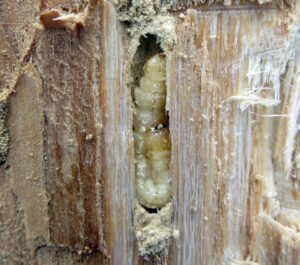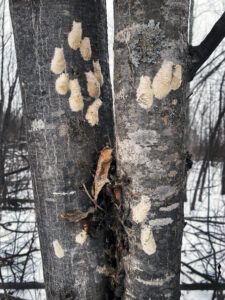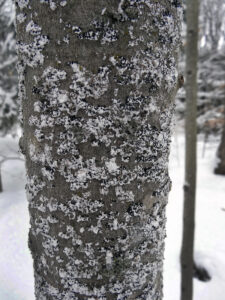
An emerald ash borer larva overwinters by curling into a J shape inside a channel in an ash tree in Brookfield in 2019. / Photo Credit: Bill McNee, Wisconsin DNR
By Michael Hillstrom, DNR Forest Health Specialist, Fitchburg
Michael.Hillstrom@wisconsin.gov
As winter’s chill persists, Wisconsin Department of Natural Resources (DNR) Forest Health staff members are often asked how cold it needs to get to kill insects, especially invasives.
The answer varies from species to species, but many insects are well adapted to dealing with freezing winter temperatures. Some, such as monarchs, avoid the issue and migrate south for the winter. Others, such as multicolored Asian ladybeetles, annoy us with their presence in our homes and offices as they try to avoid the cold until spring.

Spongy moth egg masses spend the winter on tree trunks in Iron County. in February 2024. / Photo Credit: Linda Williams, Wisconsin DNR
But most insects can survive winter cold by building up cryoprotectant chemicals (similar to antifreeze) in their blood so they don’t freeze. By the time a polar vortex impacts us mid-winter, many insects are ready to deal with even extreme cold.
However, cold snaps in fall or spring can have a greater impact because insects are not as well-protected at those times. Other factors, such as humidity, may also play a role in insect winter survival.
Here are a few examples of insects’ cold tolerance:
- Emerald ash borer (EAB) larvae overwinter inside trees, which provides additional protection (wind chill does not impact them). EAB mortality may increase to greater than 50 percent at temperatures colder than -20⁰ F. During a polar vortex in 2019, more than 80 percent of EAB larvae found in an ash tree in the Milwaukee area were found to be alive after a low of -26⁰ F.
- Similarly, spongy moths can survive -20⁰ F in fur-protected egg masses, often hidden in bark crevices. Egg masses scraped off trees should be disposed of and not dropped into the snow, because eggs insulated under snow may still hatch in the spring.
- Native Eastern larch beetles causing increasing damage to tamarack stands due to climate change can survive temperatures as low as -40⁰ F or even -50⁰ F.
- Forest tent caterpillar eggs (laid in egg masses on twigs) are also capable of surviving temperatures below -40⁰ F.
Although extreme cold will cause mortality of some insects, it’s generally not effective at greatly reducing the numbers of some of our most notorious pest insects. That explains why they were able to establish a presence in Wisconsin forests in the first place.

A beech tree trunk is populated with fluff-covered scale insects associated with beech bark disease during winter at Whitefish Dunes State Park. / Photo Credit: Linda Williams, Wisconsin DNR
With the effects of climate change on the rise, increasing winter temperatures may benefit insect survival, but may also cause more temperature extremes and rapid temperature fluctuations that insects are not able to survive.
